Change font size -A A +A ++A
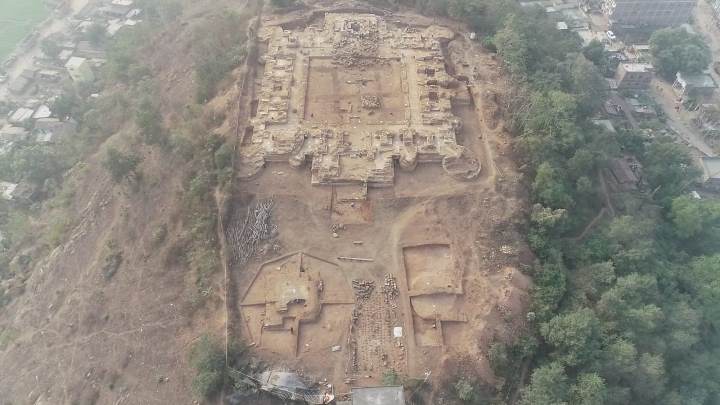
Bird's eye view of Lalpahari excavation site at Lakhisarai.
Our Bureau/
Amid Corona fear, Bihar has managed to set an exemplary work in the field of promotion and conservation of treasure troves of yesteryear.
After completing hundred percent excavations, the first excavated hilltop Buddhist monastery of Ganga valley has been unearthed beneath the earth at Lakhisarai. And the Bihar government initiates for developing the site with the construction of a modern museum at Lakhisarai.

Buddha’s sculpture at Lakhisarai.
Lalpahari Jaynagar excavation, a joint venture by the department of ancient Indian history, culture and archaeology, Visva Bharati University, Santiniketan and Bihar heritage development society, department of art, culture and youth affairs of government of Bihar under the supervision of Professor Anil Kumar, a senior faculty of history at Visva Bharati University, has been completed. It has created a record in the recent history of Bihar, completed the project within 3 years for the first time in the history of the state. Secondly, the potentiality of the excavation compelled Bihar government on 2020 to declare for overall development of the site at Lakhisarai.
“Bihar government has already started the construction of a modern museum at Balgudar and 2021 has been targeted to finish it. An under taken of the department of art, culture and youth affairs of government of Bihar, this project is spread across 1.5 Acres of land and would be costed Rs 2722.38 lakh,” said Bijoy Kumar Chaudhary, chairperson of Bihar heritage development society, department of art, culture and youth affairs of government of Bihar.

Experts concerned like Anil Kumar (white shirt) and Bijoy Kumar Chaudhary (in dark blue shirt) at Lalpahari.
“In December 2016 a heritage walk was organized by Bihar heritage development society at Lakhisarai with the explicit aim to acquaint the masses with the history, origins, myth, folk-culture and art of the region. No one on that day even could imagine such huge success, the recovery of a such a big Buddhist monastery could be possible below the earth here,” Chaudhary recalls.
According to him excavation commenced on Lalpahari on November 25, 2017 after Bihar chief minister, Nitish Kumar officially inaugurated it at the site of Lalpahari. “The chief minister constantly monitored the project. He had shown keen interests for preserving the rich sculptural heritages of Lakhisarai and had sanctioned the construction of a modern museum at Lakhisarai. The foundation stone of the museum, which is now under construction, has been laid by the chief minister also,” Chaudhary pointed out.

The story of Lalpahari excavation was unique in its kind in Bihar, claimes Anil Kumar. “A high level survey committee comprising of experts concerned conducted extensive survey of various sites at Lakhisarai including structural sites, sculptural find-sports and settlement mounds. The team recommended the preservation of seven of the historical sites as state protected monuments. The report also insisted on the urgency of an archaeological excavation of a monument buried beneath here,” he recalls.
In the follow up, Bihar government had managed a MoU between department of ancient Indian history, culture and archaeology, Visva Bharati University, Santiniketan and Bihar heritage development society on 2017 for archaeological exploration and excavation in Lakhisarai.

Events at the excavation site.
By August 2019 six historical sites namely Lalpahari, Sarsanda hill, Ghosikundi hill, Bicchwe hill, Lai, Nongarh were decleared as state protected monuments. The work for the conservation of the state protected monuments is now on progress, Kumar said.
“The conservation works of the excavated Monastic remains at Lalpahari has been handed over to the Bihar Building construction Corporation Limited,” Kumar said.
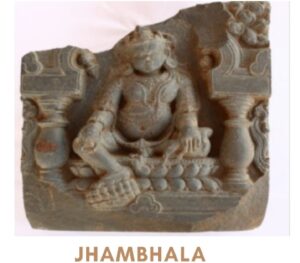
Jhambhala
‘s sculpture found at Lakhisarai.
Krimila Visaya, an ancient administrative and religious center of Pala dynasty was earlier identified in and around Lakhisarai located some 170 km east of Patna was earlier explored in fragments by the British and Indian scholars in the 19 th and 20 th century. But finally Kumar and his team members had done the excellent works-unearthed the Srimaddhama Vihara (monastery).
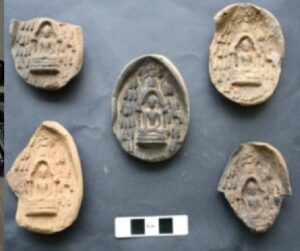
some items discovered at Lakhisarai excavation.
The two burnt clay sealing recovered from the site records the name Srimaddharmaviharik aryabhiksusanghasya. This may be translated as “This is the sealing| of the council of monks of Srimaddhama Vihara (monastery)”. The language of the record is Sanskrit and the script is Siddhamatrika of about 8th/9th century CE.
This discovery is of paramount significance in the understanding of the history of monastic Buddhism in early medieval Magadha in general and the history of the historically identified Krmila region in Lakhisarai in southern Bihar in particular. This evidence clearly proves that the monastery atop Lalpahari in Jaynagar was a ‘vihara’ category of monastic evidence. While a number of mahaviharas and in one instance a ‘viharika’ is known from epigraphic and archaeological records of eastern India, no evidence of a ‘vihara’-level monastic architecture has been so far discovered from any part of Bihar. The only parallel evidence is provided by a monastery excavated at Jagjivanpur in north Bengal.
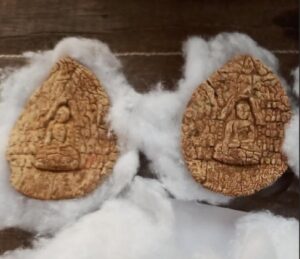
wooden votive tablets that were found during excavation at Lakhisarai.
The uniqueness of this discovery is that firstly it is the first hilltop monastic site excavated in Ganga valley. Further, architectural features like well-preserved interconnected cells, remnants of wooden doorframes, existence of three robust and huge bastion on each side of the monastery, discovery of dozens of wooden inscribed seals/sealings, and finally, the evidence of application of red, green, yellow, white and black colours on lime-plastered floors makes the architecture of this monastery the first of its kind on the map of eastern Indian Buddhist establishments. Dozens of wooden votive tablet were discovered during the excavation. One has a figure on it, has a person, most probably Buddha sitting in Padmasana in Bhumisparsha mudra.
“ This discovery is significant because wooden votive tablet are usually found in South-East Asian regions and this is the first set of wooden votive tablet found in this region,” Kumar claimed.
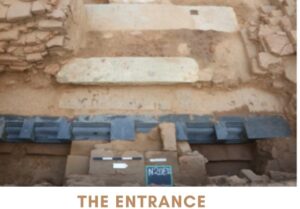
The entrance of Lakhisarai ‘Vihara’ in early times.
Kumar further added that the main entrance to the ‘vihara’ on the eastern had a scatter of sculptures that once adorned by structure. It also had multiple wooden doors which have not survived but its iron hinges were recovered during excavation. According to him, the entrance was adorned with a black stone polished threshold much like the temples of the modern days.
The buried structure beneath the soil was not only an exemplary monument with rooms and bastions but also abundant artifacts, day to day items used by its residents, objects of ritualist use veneration, or other smaller architectural fragments. These included sculptures, pot sherds, seals, votive tablets, cowries, iron objects, copper objects,charcoal amongst many others. Every object, their find spot and their significance has been meticulously recorded and analyzed, Kumar pointed out.

Well planed sewerage system at the ‘vihara’ in Lakhisarai.
One of the greatest sculptural find of the excavation, the Gargoyle displays the intricate carvings and polish both features of early medieval art in eastern India. Located near the North-Eastern Bastion, this acted as the mouth of the drain that carried the water from the courtyard and dispelled it outside the structure.
In the due course of the exploration, over 500 Brahmanical and Buddhist sculptures of deities were documented and over some 200 sculptures were preserved in makeshift museum at Lakhisarai.

Black stone sculptures that were found in Lakhisarai excavation.
Apart from it, the Lintel was found in the buried in the passage leading to the main sanctum on the western part of the structure. This once adorned the entrance of the sanctum chamber. The lintel represents two Bodhisattvas, Manjushri and Avlokiteshvara. Besides, the Buddhist deity of health and prosperity, the sculpture of Jhambhala was found near the entrance on the eastern side of the structure. The deity adorned the lintel above the entrance in the ‘Vihara’. He is seated on a lotus throne with a mongoose in his right hand. The image is carved on granite.
The name Srimaddharmavihara is of equally considerable significance. While we have so far no evidence of this specific name occurring in any other epigraphic or transmitted text of the region, the name clearly indicates prestige Mahayana Buddhism enjoyed in early medieval Magadha. The name probably also signifies a close association of the monastery with Mahayana esoteric practices, as also vindicated by its very location, atop an isolated hill away from the habitation clusters of Krimila.

Seal found at Lakhisarai.
Some historians claim that since no such inscription has yet been found, it’s not clear to ascertain to identify the actual builder of this ‘vihara’ at Lalpahari. “But there is no doubt that this ‘vihara’ was constructed during the time of Pala who were strong patrons of spreading of Buddhism. The western parts of rive Krimila was falling under the territory of Magadha which was ruled by Pala kings time to time and hence it was the part of Pala’s Vanga. Intensive research should be done in this direction to search out the actual history,” said Shivshanker Singh Parijat, a Bhagalpur based historian.
However, Chaudhary remains quite confident to change the fate of Lakhisarai and its surroundings in terms of tourism in coming days.



Leave a Reply